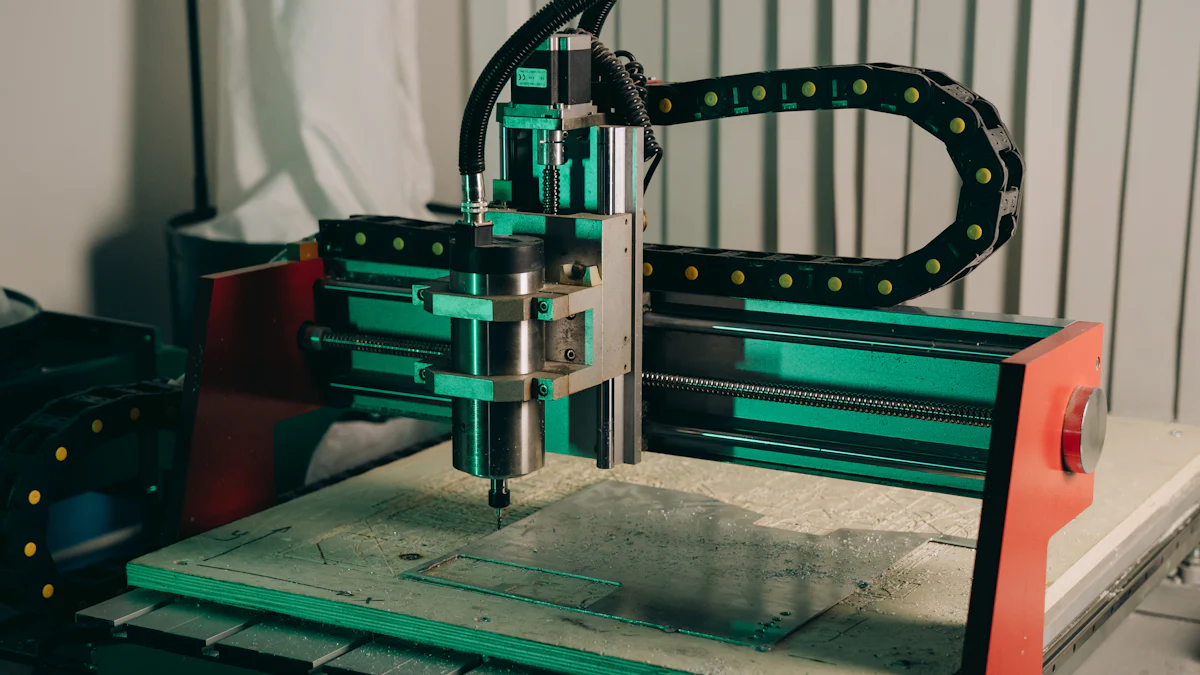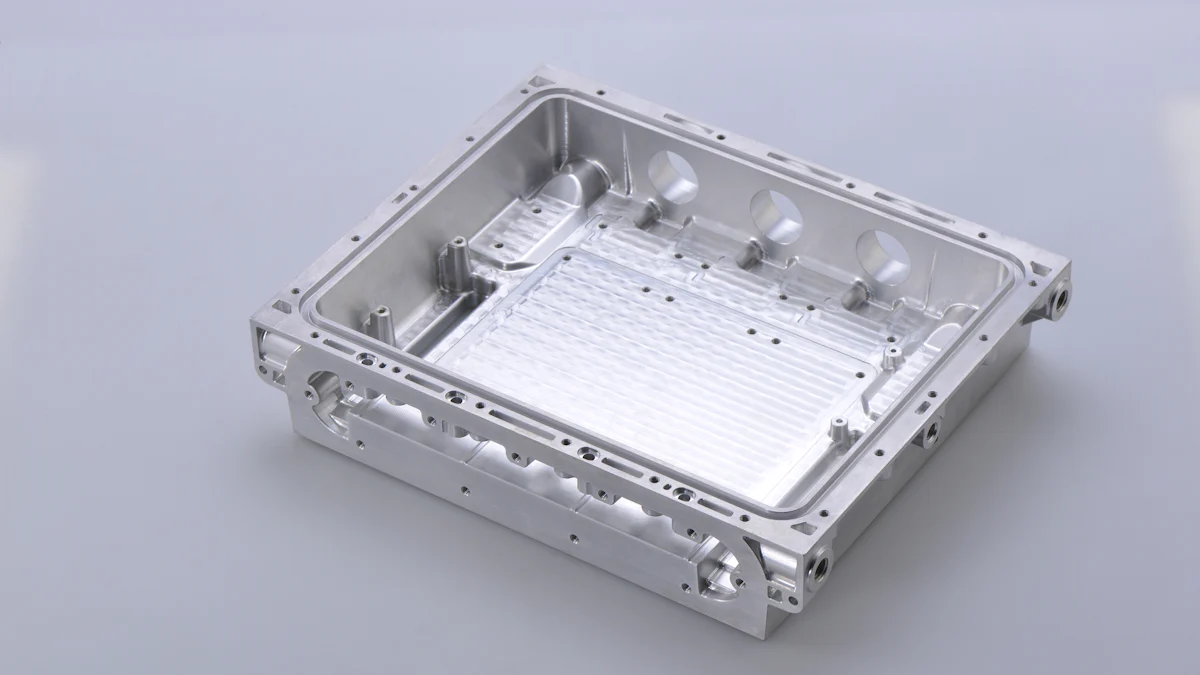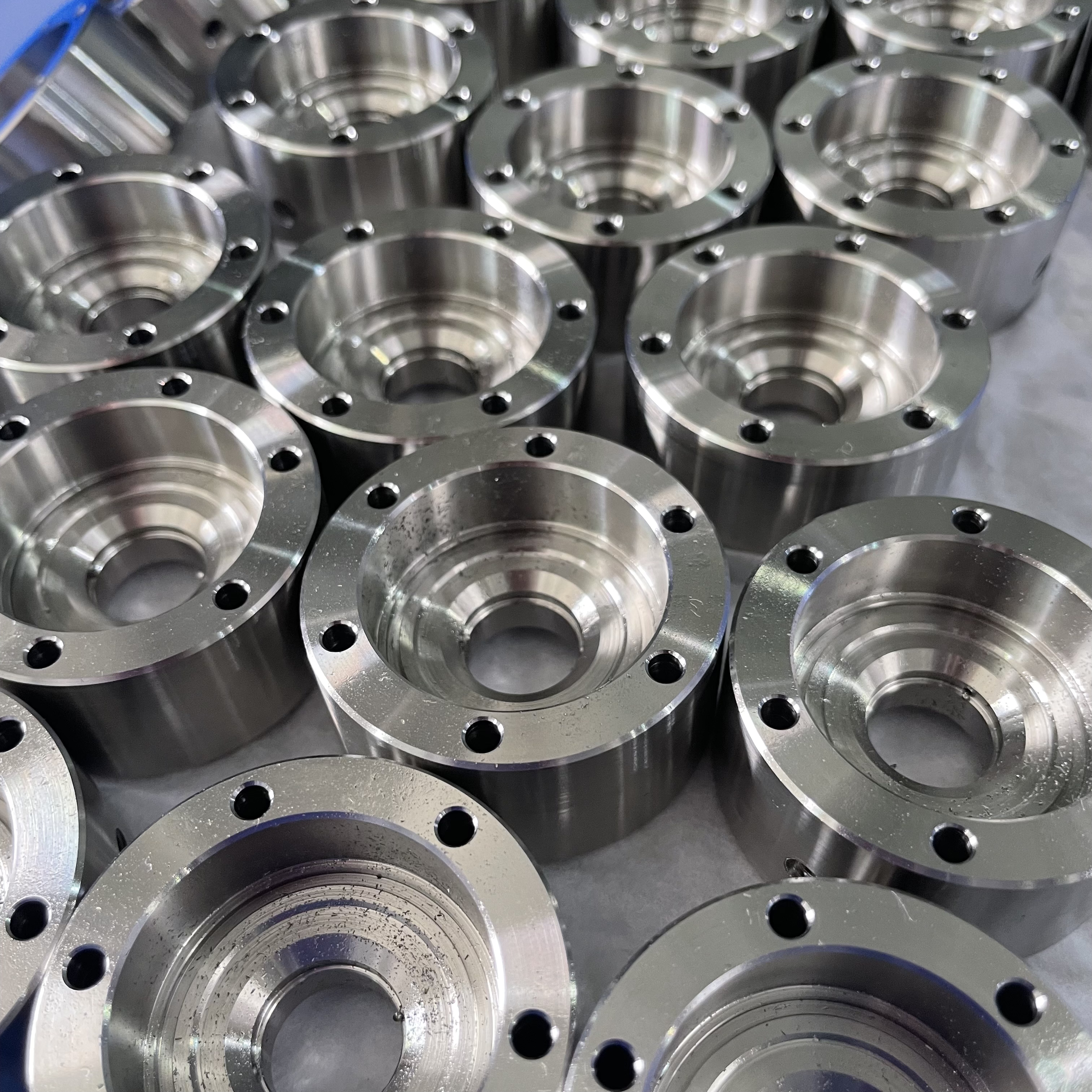How to Select the Best Material for Your CNC Project

Choosing the right material is essential for CNC machining success. Material characteristics like strength, heat resistance, and machinability directly affect the quality and efficiency of your project. For instance, materials with good heat resistance allow faster cutting speeds and reduce tool wear, improving machining efficiency. Similarly, lighter materials like aluminum enhance performance in aerospace applications, while stainless steel offers superior corrosion resistance for marine environments. Material availability and cost also play a role, as high-demand materials can increase expenses. By understanding these factors, you can ensure your project meets its functional and budgetary goals.
Key Takeaways
Picking the right material is key for CNC machining success. Look at things like strength, heat resistance, and ease of cutting to improve your project.
Check material prices and availability to stay on budget. Popular materials can cost more, so balance quality with price.
Testing helps find design problems early. Trying materials in real-life conditions saves time and money, making sure your final product works well.
Choose materials that fit your CNC machine's abilities. Know your machine's speed and tools to get the best results.
Always stay safe when using composites. Wear safety gear and keep your workspace clean to protect yourself and your work.
Factors to Consider for CNC Projects
Material Properties
Strength and durability
You must evaluate the mechanical properties of materials, such as strength, hardness, and toughness, to ensure they meet your project’s demands. For example, heavier parts often require stronger materials, while lighter components can use materials with lower density. If your project involves high-stress environments, prioritize materials with excellent durability to prevent failure.
Machinability and cutting ease
Some materials are easier to machine than others. Metals like aluminum offer high machinability, making them ideal for CNC machining. In contrast, harder materials like steel may require specialized tools and slower cutting speeds. Choosing a material with good machinability reduces tool wear and machining time, improving efficiency.
Heat resistance and thermal stability
Thermal properties, such as heat resistance and thermal conductivity, play a critical role in material selection. Materials with high thermal stability perform better in applications involving high temperatures. For instance, titanium resists heat well, making it suitable for aerospace and automotive CNC projects.
Cost and availability
Material costs and availability directly impact your project’s budget and timeline. Rare materials or those in high demand can increase expenses. Always balance your material requirements with cost considerations to ensure affordability without compromising quality.
Project Requirements
Functionality and application
Your material choice must align with the intended application. For example, projects requiring flexibility may benefit from plastics like nylon, while those needing rigidity might use steel. The right material ensures your project functions as intended.
Aesthetic needs (e.g., finish, color)
If appearance matters, consider materials that offer the desired finish or color. Acrylic, for instance, provides a glossy finish, making it ideal for decorative CNC projects.
Environmental exposure (e.g., moisture, chemicals)
Materials exposed to harsh environments must resist moisture, chemicals, or UV radiation. Stainless steel offers excellent corrosion resistance, while plastics like ABS withstand chemical exposure effectively.
CNC Machine Capabilities
Spindle speed and tool compatibility
Your CNC machine’s spindle speed and tool compatibility determine which materials you can machine. Softer materials like plastics require lower spindle speeds, while metals may need higher speeds and specialized tools.
Precision and tolerance requirements
Some materials are harder to machine to tight tolerances. For example, plastics may deform under heat, affecting precision. Always match your material choice to your CNC machine’s ability to achieve the required tolerances.
Material handling capacity
CNC machines have limits on material thickness and hardness. For instance, sheet metal thicknesses between 0.020 and 0.250 inches are common. Thicker or harder materials may require additional passes, increasing machining time and cost.
Common Materials for CNC Machining

When working on CNC machining projects, selecting the right material is crucial. Below are some of the most common materials used in CNC machining, categorized by type.
Metals
Aluminum
Aluminum is one of the most popular candidate materials for CNC machining. Its high machinability and excellent strength-to-weight ratio make it ideal for industries like aerospace and automotive. Aluminum 6061, a general-purpose alloy, offers good corrosion resistance and workability, while Aluminum 7075 provides higher strength for demanding applications. These properties make aluminum a versatile choice for both prototypes and production parts.
Steel
Steel is another widely used material, valued for its strength and durability. Stainless steel, in particular, resists wear and corrosion, making it suitable for medical and marine environments. Carbon steel, known for its machinability and cost-effectiveness, is often used in structural components. Steel’s toughness ensures reliability in high-stress applications.
Brass
Brass, an alloy of copper and zinc, is soft and highly workable. It also resists corrosion, making it a great choice for plumbing fittings and decorative hardware. Its aesthetic appeal and ease of machining make it a favorite for projects requiring intricate designs.
Titanium
Titanium combines lightweight properties with exceptional strength and corrosion resistance. It is biocompatible, making it ideal for medical implants, and its heat resistance suits aerospace and military applications. While more expensive, titanium’s unique properties justify its use in specialized projects.
Plastics
Property | ABS | Polycarbonate (PC) |
|---|---|---|
Heat deflection | 215°F (102°C) | 280°F (138°C) |
Tensile strength | 6,091 psi (42MPa) | 10,442 psi (72MPa) |
Elongation at break | 30% | 100% |
ABS
ABS is a durable and cost-effective plastic. It is easy to machine and provides good impact resistance, making it suitable for enclosures, prototypes, and consumer products. However, it has a lower heat deflection temperature compared to other plastics.
Polycarbonate
Polycarbonate (PC) offers higher tensile strength and heat resistance than ABS. It is ideal for applications requiring transparency and toughness, such as protective covers and lenses. Its flexibility and durability make it a reliable choice for demanding environments.
Nylon
Nylon is a strong and lightweight plastic with excellent wear resistance. It is commonly used in gears, bushings, and other mechanical components. Its low friction coefficient makes it ideal for moving parts.
Acrylic
Acrylic is known for its optical clarity and glossy finish. It is often used in decorative projects, signage, and display cases. While it is less durable than polycarbonate, its aesthetic appeal makes it a popular choice for visual applications.
Woods
Hardwoods (e.g., oak, maple)
Hardwoods are dense and durable, making them suitable for intricate designs and high-quality products. They require more powerful CNC machines due to their toughness. Projects like furniture and decorative carvings often use hardwoods for their strength and aesthetic appeal.
Softwoods (e.g., pine)
Softwoods are lighter and easier to machine, making them ideal for beginners. They are cost-effective and work well for projects prioritizing speed over durability. However, they are less resistant to wear and scratches, limiting their use in high-traffic items.
Plywood and MDF
Plywood and MDF (medium-density fiberboard) are engineered woods that offer consistent density and stability. They are affordable and easy to machine, making them popular for cabinetry, signage, and prototypes. Their uniform structure ensures predictable results during machining.
Composites
Carbon fiber
Carbon fiber is a lightweight yet strong material often used in high-performance applications like aerospace, automotive, and sports equipment. Its strength-to-weight ratio surpasses most metals, making it a suitable material for projects requiring durability without added weight. However, machining carbon fiber presents unique challenges. Its abrasive nature wears down tools quickly, so you need specialized equipment like polycrystalline diamond (PCD) tips. These tools, while effective, can be costly. Additionally, machining carbon fiber generates fine dust particles that are harmful if inhaled and can contaminate other parts. Proper ventilation and dust collection systems are essential to maintain safety and cleanliness. You must also handle carbon fiber carefully, as it can suffer from internal stress and degradation during machining.
Fiberglass
Fiberglass, a composite made from glass fibers and resin, offers excellent strength and corrosion resistance. It is commonly used in marine, construction, and industrial applications. Fiberglass is relatively easy to machine compared to carbon fiber, but it still requires sharp tools to avoid fraying or splintering. Dust management remains critical when working with fiberglass, as the fine particles can irritate the skin and respiratory system. Its affordability and versatility make it a popular choice for projects where cost-effectiveness and durability are priorities.
Laminates
Laminates consist of multiple layers of materials bonded together, often combining the strengths of different substances. They are widely used in furniture, flooring, and decorative applications. Laminates are easy to machine and provide a consistent finish, making them ideal for CNC projects requiring precision. However, you should ensure that the bonding between layers remains intact during machining. Using sharp tools and proper feed rates helps prevent delamination. Laminates also come in various finishes, allowing you to achieve both functional and aesthetic goals in your project.
Tip: When working with composites, always prioritize safety by using protective gear and maintaining a clean workspace. Proper tool selection and dust management systems will improve both the quality of your work and your safety.
How to Select the Right Materials
Best Practices for Metals
Tool selection and cutting speeds
When working with metals, selecting the right tools and cutting speeds is essential for achieving optimal results. Use tools made from durable materials like carbide or high-speed steel to handle the hardness of metals. Adjust cutting speeds based on the metal type. For example, softer metals like aluminum allow higher speeds, while harder metals like steel require slower speeds to prevent tool wear. Consider the material's heat resistance and hardness to avoid deformation or excessive tool damage. For applications requiring heat dissipation, metals like aluminum and copper are excellent choices.
Managing heat and tool wear
Heat buildup during machining can damage both the material and the tools. To manage heat effectively, use coolants or lubricants to reduce friction and maintain temperature control. Ensure proper chip evacuation to prevent clogging and overheating. For harder metals like titanium, slower feed rates and specialized coatings on tools can minimize wear. Always match the material's properties to the application, such as using stainless steel for corrosion resistance in marine environments.
Best Practices for Plastics
Avoiding melting and deformation
Plastics are prone to melting and deformation due to heat buildup. To prevent this, optimize cutting parameters like feed rate and spindle speed. Use sharp tools with appropriate geometry to reduce friction. Coolants or air blasts can help dissipate heat and evacuate chips effectively. Proper clamping and fixturing ensure the material stays stable during machining, reducing stress and deformation. Pre-conditioning plastics by maintaining consistent temperatures can also improve machining outcomes.
Achieving smooth finishes
Achieving a smooth finish on plastics requires careful attention to tooling and cutting conditions. Use tools designed for plastics, as they produce cleaner cuts. Lower feed rates and higher spindle speeds often result in better surface quality. Polishing the finished part with fine-grit abrasives can enhance its appearance. For transparent plastics like acrylic, flame polishing can create a glossy, professional finish.
Best Practices for Woods
Preventing splintering and tear-out
Wood materials can splinter or tear out during machining, especially along grain lines. To minimize this, use sharp cutting tools tailored to the specific wood type. Adjust feed rates and cutting speeds for better control. Applying masking tape along the cut line can reduce tear-out. For intricate designs, routing in small increments, such as 1/8-inch depths, ensures cleaner cuts. Climb-cutting in tear-out-prone areas can also improve results.
Managing dust and debris
Wood machining generates significant dust and debris, which can affect both safety and precision. Use dust collection systems to keep your workspace clean and maintain visibility. Sharp tools reduce the amount of fine dust produced. Regularly clear debris from the cutting area to prevent clogging and ensure smooth operation. Proper ventilation and protective gear, such as masks and goggles, are essential for safety.
Tip: Always match your material choice to your CNC machining capabilities and project requirements. This ensures you select the right stock for your needs while maintaining efficiency and quality.
Best Practices for Composites
Handling abrasive materials
Composites like carbon fiber and fiberglass are highly abrasive, which can wear down tools quickly. To handle these materials effectively, you need to choose the right tools and machining techniques. Carbide tools work well due to their strength and durability, offering cleaner cuts than diamond tools, even though they wear out faster. Sharp tools are essential to minimize delamination and prevent hanging fibers from forming during machining.
Adjusting cutting speeds is another critical step. For most composites, speeds between 550 and 760 meters per minute deliver optimal results. Start with a feed rate of 0.076 millimeters per tooth to maintain precision and avoid damaging the material. Positive rake angles on your tools can reduce heat buildup and improve the shearing of fibers, ensuring cleaner cuts.
Heat management is vital when machining composites. Excessive heat can melt the resin and compromise the material's integrity. Use coolants or a cold air gun to keep temperatures under control. These methods also help manage dust, which is a common byproduct of machining composites. Dust collection systems and proper ventilation are necessary to maintain a safe and clean workspace.
Ensuring structural integrity
Maintaining the structural integrity of composites during CNC machining requires careful planning and execution. Hydraulic chucks are an excellent choice for securing tools, as they reduce run-out and improve stability. This ensures consistent cuts and prevents damage to the material.
When machining, avoid excessive force that could weaken the composite layers. Use sharp tools and adjust feed rates to minimize stress on the material. Cutting in smaller increments can also help preserve the bonding between layers, reducing the risk of delamination.
Nonabrasive methods like laser cutting can be an alternative for composites. While these methods minimize material loss, they may introduce thermal damage. Always evaluate the trade-offs before choosing a cutting method. By following these practices, you can achieve precise results while maintaining the strength and durability of your composite materials.
Tip: Always wear protective gear when working with composites. Fine dust particles can harm your respiratory system and skin. A clean and safe workspace ensures better results and protects your health.
Prototyping and Testing Materials

Why Prototyping Matters
Identifying issues early
Prototyping helps you uncover potential design flaws before full-scale production. By testing functionality, you can evaluate how well the selected material performs under real-world conditions. For example, a prototype made from the wrong material might fail to meet strength or flexibility requirements, leading to costly revisions. Early identification of these issues ensures your final product meets expectations.
Saving time and resources
Prototyping streamlines the development process by reducing unnecessary iterations. Choosing the right material for your prototype minimizes waste and shortens production timelines. Additionally, the tactile qualities and ergonomics of the prototype allow you to gather accurate user feedback. This insight helps refine your design while keeping costs under control.
Testing Methods
Stress and durability tests
Durability testing ensures your material withstands the demands of its intended application. Methods like ultrasonic testing and X-ray inspection reveal internal flaws that could compromise structural integrity. Magnetic particle inspection is another effective technique for identifying surface and near-surface defects in ferromagnetic materials. These tests provide valuable data to confirm your material's reliability.
Surface finish evaluations
Surface quality plays a critical role in the appearance and functionality of your CNC project. Visual inspection quickly identifies major flaws, while tools like profilometers and surface roughness testers provide detailed measurements. These evaluations help you achieve the desired finish, whether for aesthetic or functional purposes.
Refining Material Choices
Adjusting material or machining parameters
Prototyping results often highlight areas for improvement. You might need to switch to a material with better heat resistance or adjust machining parameters like feed rate and spindle speed. These refinements ensure your material aligns with project requirements and CNC machining capabilities.
Scaling up for production
Prototyping also prepares you for large-scale manufacturing. By aligning prototype materials with production methods, you can avoid unexpected challenges during scaling. A well-tested prototype ensures smoother transitions to mass production, saving time and resources.
Tip: Always test materials under conditions that mimic their final use. This approach ensures your project meets both functional and aesthetic goals.
Selecting the right material is essential for successful CNC machining. Understanding material properties like strength, machinability, and heat resistance ensures your project meets functional and aesthetic goals. Matching these properties with your CNC machine’s capabilities, such as precision and spindle speed, helps you achieve optimal results.
Prototyping and testing play a vital role in refining material choices. Testing prototypes under real-world conditions uncovers design flaws early, saving time and resources. It also ensures the material aligns with manufacturing methods and user expectations.
Experiment with different materials and machining parameters to choose the right stock for your project. Consult reliable resources to make informed decisions and create high-quality CNC machining outcomes.
FAQ
What is the best material for beginners in CNC machining?
Softwoods like pine or plastics such as ABS are great for beginners. These materials are easy to machine, affordable, and forgiving of mistakes. They allow you to practice without risking expensive tools or materials.
How do I choose between metals and plastics for my project?
Consider your project’s requirements. Metals offer strength and durability, while plastics provide flexibility and lightweight properties. Evaluate factors like application, environmental exposure, and cost to make the right choice.
Can I use the same tools for all materials?
No, each material requires specific tools. For example, carbide tools work well for metals, while plastics need sharp tools to prevent melting. Always match your tools to the material for optimal results.
How does material thickness affect CNC machining?
Thicker materials require more passes and longer machining times. Ensure your CNC machine can handle the material’s thickness to avoid tool wear or incomplete cuts.
Why is heat management important during CNC machining?
Heat buildup can damage materials and tools. Proper heat management, such as using coolants or adjusting cutting speeds, ensures precision and extends tool life.
See Also
Become Proficient in CNC Machining: Drawing and Material Insights
Grasping Material Needs for CNC Precision Machining Success
Excelling in CNC Milling for High-Precision Part Creation
Navigating Machining Challenges: NC Milling and CNC Engraving Solutions
Investigating CNC Machining Services for Accurate Production Needs
About US
Follow Us
Your prototype holds unparalleled significance, and we deeply value its uniqueness. Collaborating with you during the preparation phase for running your prototype or parts is a commitment we gladly embrace. Whether it's a single part or a complex assembly, we are dedicated to selecting the optimal tools and pathways to bring your envisioned product to life.
At Precision Fab CNC Machining, we specialize in producing parts for prototypes, short runs, and high-volume production. Our prototyping machine capabilities extend across metal, plastic, and wood machining, with welding fabrication services available to complement and finalize your prototype if required.
Address
Address: Room320 10F, Building A,Nanshan international building, Dayawan District, Huizhou, Guangdong, 516001 China
Contacts
billy@timaycnc.com

